Raffia palm
Raffia palms (Raphia) are a genus of about twenty species of palms native to tropical regions of Africa, and especially Madagascar, with one species (R. taedigera) also occurring in Central and South America.[1] R. taedigera is the source of raffia fibers, which are the veins of the leaves, and this species produces a fruit called "brazilia pods", "uxi nuts" or "uxi pods".[2]
| Raffia palm | |
|---|---|
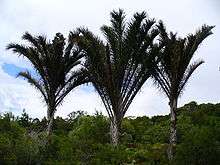 | |
| Scientific classification | |
| Kingdom: | Plantae |
| Clade: | Tracheophytes |
| Clade: | Angiosperms |
| Clade: | Monocots |
| Clade: | Commelinids |
| Order: | Arecales |
| Family: | Arecaceae |
| Subfamily: | Calamoideae |
| Tribe: | Lepidocaryeae |
| Genus: | Raphia P.Beauv. |
They grow up to 16 m (52.5 ft) tall and are remarkable for their compound pinnate leaves, the longest in the plant kingdom; leaves of R. regalis up to 25 m (82.38 ft) long[3] and 3 m (9.84 ft) wide are known. The plants are monocarpic, meaning that they flower once and then die after the seeds are mature. Some species have individual stems which die after fruiting, but have a root system which remains alive and sends up new stems which fruit.
Species
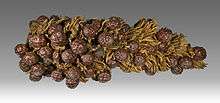
| Image | Scientific name | Distribution |
|---|---|---|
| Raphia africana Otedoh | Nigeria, Cameroon | |
| Raphia australis Oberm. & Strey | Mozambique, South Africa | |
.jpg) | Raphia farinifera (Gaertn.) Hyl. | Africa from Senegal to Tanzania, south to Mozambique and Zimbabwe |
| Raphia gentiliana De Wild. | Democratic Republic of Congo, Central African Republic | |
| Raphia hookeri G.Mann & H.Wendl. | western and central Africa from Liberia to Angola | |
| Raphia laurentii De Wild. | Angola, Democratic Republic of Congo, Central African Republic | |
| Raphia longiflora G.Mann & H.Wendl. | from Nigeria to Democratic Republic of Congo | |
| Raphia mambillensis Otedoh | Nigeria, Cameroon, Central African Republic, Sudan | |
| Raphia mannii Becc. | Nigeria, Bioko | |
| Raphia matombe De Wild. | Cabinda, Democratic Republic of Congo | |
| Raphia monbuttorum Drude | Nigeria, Cameroon, Chad, Central African Republic, South Sudan | |
| Raphia palma-pinus (Gaertn.) Hutch. | western Africa from Liberia to Cabinda | |
| Raphia regalis Becc. | central Africa from Nigeria to Angola | |
| Raphia rostrata Burret | Cabinda, Democratic Republic of Congo | |
| Raphia ruwenzorica Otedoh | eastern Democratic Republic of Congo, Rwanda, Burundi | |
| Raphia sese De Wild. | Democratic Republic of Congo | |
.jpg) | Raphia sudanica A. Chev. | western Africa from Senegal to Cameroon |
 | Raphia taedigera (Mart.) Mart. | Nigeria, Cameroon, Central America (Costa Rica, Nicaragua, Panama), South America (Colombia, Pará State of Brazil) |
| Raphia textilis Welw. | Cabinda, Democratic Republic of Congo, Gabon, Angola | |
| Raphia vinifera P. Beauv. | western Africa from Democratic Republic of Congo to Benin | |
Cultivation and uses
Fiber
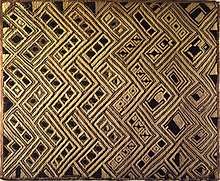
Raffia fibre is widely used throughout the world. It is used in twine, rope, baskets, placemats, hats, shoes, and textiles.
The fiber is produced from the membrane on the underside of each individual frond leaf. The membrane is taken off to create a long thin fiber which can be dyed and woven as a textile into products ranging from hats to shoes to decorative mats.
Plain raffia fibers are exported and used as garden ties or as a "natural" string in many countries. Especially when one wishes to graft trees, raffia is used to hold plant parts together as a more "natural" rope.
Raffia fibers have many uses, especially in the area of textiles and in construction. In their local environments, they are used for ropes, sticks and supporting beams, and various roof coverings are made out of its fibrous branches and leaves. A strand of raffia has a maximum length of about 1.5 m and an irregular width. When presented on spool or hank with a length of more than one meter and a half and regular width is not really raffia, it can be synthetic raffia, produced from a plastic material (polypropylene), or artificial, just like viscose (derived from wood, therefore basic cellulose cellulosic even if chemically treated). The first company in the world to design and build plants for the production of polypropylene raffia was the Covema of Milan founded by the brothers Dino Terragni and Marco Terragni. Covema collaborated with the Swiss company Sulzer, manufacturer of flat weaving looms for natural fibers, to adapt their looms to process polypropylene raffia woven products. Polypropylene raffia fabrics are still used to make carpet backing, protective sheets, rice bags, potatoes, citrus fruit, etc. Covema also developed coating lines to cover the raffia fabric with a thin film of polyethylene in order to make the fabric waterproof.[4]
Raffia wine
Raffia palm also provides an important cultural drink. The sap contains sugars. It is traditionally collected by cutting a box in the top of the palm and suspending a large gourd to collect the milky white liquid. Unlike oil palms, this process kills the tree. Sap from both the raffia and oil palms can be allowed to ferment over a few days. When first collected from the tree, it is sweet and appears slightly carbonated. As it ages more sugar is converted. The sap is usually called wine. The raffia wine tends to be sweeter at any age when compared to oil palm wine. Both kinds of palm wine can also be distilled into strong liquors, such as Ogogoro. Traditionally in some cultures where raffia or oil palm are locally available, guests and spirits are offered these drinks from the palm trees.
The raffia palm is important in societies such as that of the Province of Bohol in the Philippines, Kuba of Democratic Republic of the Congo, Nso of Cameroon, the Igbo and Ibibio/Annang of Southeastern Nigeria, the Tiv of Northcentral Nigeria and Southwestern Cameroons, the Urhobo and Ijaw people of Niger delta Nigeria and the Yoruba of southwestern Nigeria, among several other West African ethnic nations.
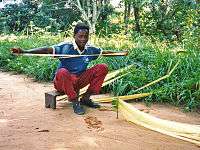 Removing the fibrous inner layer of the palm frond leaves as a first step in making raffia rope in Bandundu Province, Democratic Republic of the Congo.
Removing the fibrous inner layer of the palm frond leaves as a first step in making raffia rope in Bandundu Province, Democratic Republic of the Congo.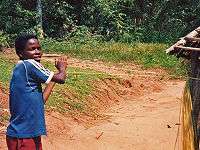 Palm frond fibers are rolled together for added strength before they are finally dried.
Palm frond fibers are rolled together for added strength before they are finally dried. Raffia is woven to make the traditional Munganji dancer suit used in Bapende ceremonies in the Gungu region of Bandundu Province, Democratic Republic of the Congo
Raffia is woven to make the traditional Munganji dancer suit used in Bapende ceremonies in the Gungu region of Bandundu Province, Democratic Republic of the Congo
Raffia palm frond as fishing pole
The people of Ogba kingdom in Rivers State and other southern Nigerians have no alternative to raffia palm fronds as fishing poles. The frond is usually cut from a young raffia palm tree. The leaves are removed and the stake is dried, which becomes very light, and the hook is attached to a line, which is tied to the stake, making it a fishing pole.
References
- Kew World Checklist of Selected Plant Families
- Tucker, A.; Redford, A.; Scher, J.; Trice, M. (2010). "Raphia taedigera". Dried Botanical ID. Fort Collins, CO: Delaware State University, Identification Technology Program, CPHST, PPQ, APHIS, USDA. Retrieved 7 October 2016.
- Hallé, F. 1977. The longest leaf in palms? Principes 21: 18.
- https://www.polimerica.it/blog-articolo.asp?id=17